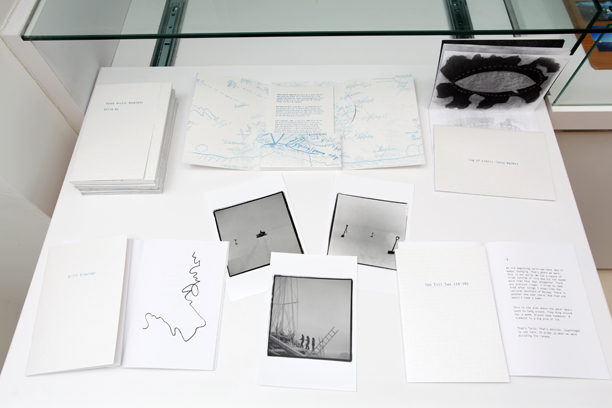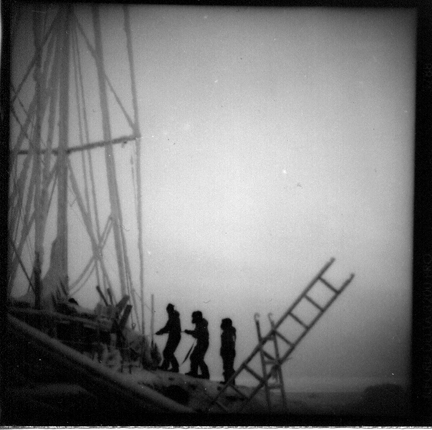Three Arctic Booklets, Special Edition
Ten till Two (10:10), Drift Drawings, Log of Limits (Snow Walks)
3 saddle stitched pamphlets, 20 pages, edition 50
includes three gelatin silver prints
Ugly Duckling Presse, June 2010
A few copies are still available from Ugly Duckling Presse
Read about Three Arctic Booklets in 500 words on Artforum.com HERE
Ten till Two (10:10), Drift Drawings, Log of Limits (Snow Walks)
3 saddle stitched pamphlets, 20 pages, edition 50
includes three gelatin silver prints
Ugly Duckling Presse, June 2010
A few copies are still available from Ugly Duckling Presse
Read about Three Arctic Booklets in 500 words on Artforum.com HERE

Excerpt, Ten till Two (10:10)
1
At the beginning North was here. But it keeps changing. That’s where we were. This is our world. We had a couple of trips outside of this map but not maybe more than four days altogether. These are pressure ridges. I tried to name them after things I know, like the national mountain of Norway. There is another one over there. And that one doesn’t have a name.
This is the area where the polar bears used to hang around. They hung around for a week. Around some hummocks. A hummock is a big pile of ice.
That’s Tartu. That’s Helsinki. Copenhagen is not here. It broke up when we were building the runway.
7
Here is the boat. And here is the wind. And this is the zone I often called our garden.
That is our world and it has shrunk. Helsinki didn’t last. It was moved over.
We called it New Helsinki. This one here is Wellington.
The limit was further. But not much further. Just behind the toilet.
The points in the distance were the validation line. The validation line is a 1km line. We need to validate our world because we are not sure it exists.
North was here. Over here somewhere. Our ice block always stayed at the same position, then we went across the top and north became south and south became north. It doesn’t really make any difference to our life. At least we weren’t drifting sideways.
This is the one moving now, the remnants of our ice block. Where we peed or where we used to pee. It’s all melted away now. This was later on. Tartu is now over here. The validation line is broken in half.
10
Ten people are put into an unknown room for one minute, maybe a little less, not more. Then they are asked to describe what they have seen. What do they remember? The descriptions are very different for each person. Nobody sees the world in the same way. We don’t have another picture world. We must see only what we can see, not more. Not more.
1
At the beginning North was here. But it keeps changing. That’s where we were. This is our world. We had a couple of trips outside of this map but not maybe more than four days altogether. These are pressure ridges. I tried to name them after things I know, like the national mountain of Norway. There is another one over there. And that one doesn’t have a name.
This is the area where the polar bears used to hang around. They hung around for a week. Around some hummocks. A hummock is a big pile of ice.
That’s Tartu. That’s Helsinki. Copenhagen is not here. It broke up when we were building the runway.
7
Here is the boat. And here is the wind. And this is the zone I often called our garden.
That is our world and it has shrunk. Helsinki didn’t last. It was moved over.
We called it New Helsinki. This one here is Wellington.
The limit was further. But not much further. Just behind the toilet.
The points in the distance were the validation line. The validation line is a 1km line. We need to validate our world because we are not sure it exists.
North was here. Over here somewhere. Our ice block always stayed at the same position, then we went across the top and north became south and south became north. It doesn’t really make any difference to our life. At least we weren’t drifting sideways.
This is the one moving now, the remnants of our ice block. Where we peed or where we used to pee. It’s all melted away now. This was later on. Tartu is now over here. The validation line is broken in half.
10
Ten people are put into an unknown room for one minute, maybe a little less, not more. Then they are asked to describe what they have seen. What do they remember? The descriptions are very different for each person. Nobody sees the world in the same way. We don’t have another picture world. We must see only what we can see, not more. Not more.
